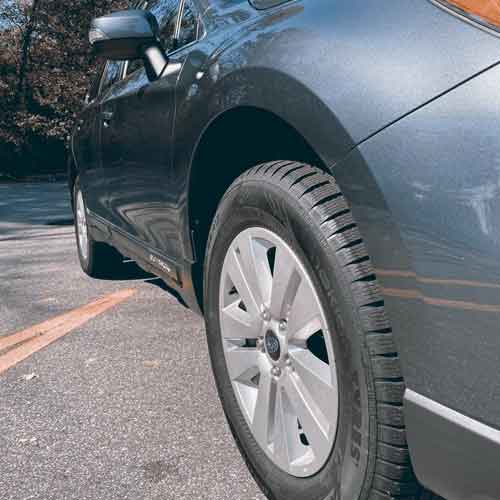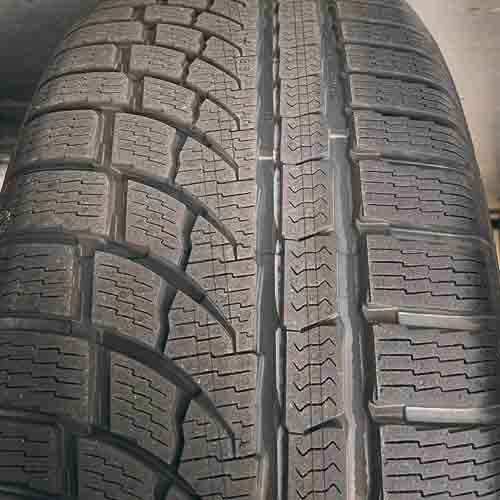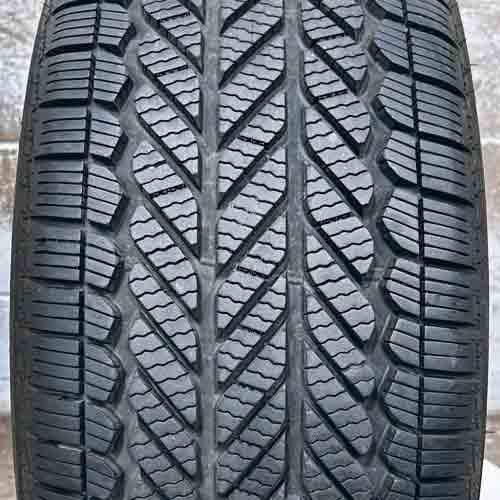he Nokian WRG4 is an ultra-high performance all-season tire, designed to provide exceptional handling and stability in various weather conditions. On the other hand, the Bridgestone WeatherPeak falls into the grand touring category, offering a balance of comfort, durability, and economy.

Table of Contents
Main Highlights
So overall the WRG4 excels in:
- Superior performance on icy tracks due to its better siping.
- Better wet performance, thanks to its more aggressive and biting tread design.
- Superior hydroplaning resistance thanks to its advanced groove structure.
Detailed Discussion on Nokian’s tire: https://tiredriver.com/nokian-wrg4-review/
Whereas the WeatherPeak tire takes the lead in:
- Greater tread longevity, offering up to 10,000 additional miles on average.
- Superior performance on snowy terrains, leveraging a design that scoops and displaces snow efficiently.
- Higher fuel efficiency, attributed to its lighter weight.
- Better directional grip and handling in dry conditions.
- Quieter and smoother ride, due to its advanced variable pitch tread and special polymer integration.
Detailed Discussion on Bridgestone’s tire: https://tiredriver.com/bridgestone-weatherpeak-review/
Internal/External Construction
The Nokian WRG4 features an intricate asymmetric tread pattern.

The tread consists of three primary ribs, and it’s beneficial to begin with the central one.
This middle (most) rib is the narrowest and runs continuously without being fully interrupted by voids.
Though the tire does offer multiple notches, which are laterally and longitudinally aligned.
And yes, you also get a lot of siping, and looking at such abundant siping structure, it makes sense why the tire provides superb winter performance.
Moreover, it also does pretty well, in terms of hydroplaning resistance, with its swooping grooves, (covering 60% of the tread), interconnected with each other, and twin circumferential channels in the middle.
Internally, the WRG4 is robust, comprising a 2-ply polyester, 2 steel belts, and 2-ply nylon build.
In contrast, the Bridgestone WeatherPeak features a symmetric design but exudes a more dynamic appearance.

Its tread is characterized by slanted, squared-off lugs interspersed with multiple biting edges, spread out through the 5 ribs (or block columns).
Together these ribs form 4 pretty spacious circumferential channels, interconnecting with each other.
The lugs feature a lot of wave-like, interlocking sipes and chamfered edges, with the sipe orientations varying across each rib.
And towards the shoulders, the sipe-design shifts. Here, the sipes are linear and laterally placed, with distinct longitudinal slits bisecting the shoulder lugs to improve lateral grip on snowy and icy surfaces.
Internally, this tire is reinforced with a sturdy 2-ply polyester carcass, augmented by 2 steel belts and a nylon cap beneath the rubber surface, offering enhanced durability and performance, yet a lighter structure at the same time, providing better fuel economy, and tread life compared to Nokian tire.
Sizes and their Specs
Nokian WRG4 comes in 14 to 20 inches rims, having following specs.
- Speed ratings: H, V and W.
- Load ratings: XL, and SL.
- Weight range: 16 to 40 lbs.
- UTQG: 500 A A.
- Treadwear warranty: 60k miles.
- All sizes have the 3pmsf and M+S certifications.
- Tread depth: 11/32″ on all.
Whereas the Bridgestone WeatherPeak offers 15 to 20 inches rims, with following features.
- Speed ratings: T, H and V.
- Load ratings: SL and XL.
- Tread depth: 10/32″ on all.
- Weight range: 17 to 30 lbs.
- Tread warranty: 70k miles.
- UTQG: 700 A A.
- Winter ratings: Yes both M+S and 3PMSF available.
Tread Longevity
The durability of tread is influenced by several factors, including the design of the tire (with tread depth being a crucial element), the composition of the tread rubber, and the tire’s overall weight.
And a closer examination of these elements reveals why the WeatherPeak outperforms the WRG4 in terms of longevity, offering up to 10,000 additional miles on average over its lifespan (comparing most of the sizes, particularly XL ones).
The Bridgestone tire benefits from a robust rubber compound, enriched with polymers known for their resistance to wear. Additionally, its lighter construction reduces the pressure on the lugs as they contact and wear against the road surface.
On the other hand, Nokian lacks with its softer and more aggressive rubber design, which is also prone to show various kinds of wear patterns too.
Though the tire does offer slightly deeper tread depth. How that helps? Well although it lacks here it still takes a good amount of time till it reaches down to the 2/32″ depth mark, the legal tread limit in the U.S.
Winter Performance
When exploring options for “versatile all-weather tires with decent winter performance”, both boys here emerge as top contenders, excelling in all performance metrics such as snow and ice acceleration, braking efficiency, and precise (enough) handling.
Personally I love their responsiveness to steering inputs, and acceleration on light snowy terrains, which of course also explains them having 3-Peak Mountain Snowflake ratings alongside their M+S (Mud and Snow) designations.
(But why is 3PMSF related to acceleration? Well I discussed it in details here: https://tiredriver.com/3pmsf-and-ms-ratings/ You may wan to check it out).
So what’s the deal here? Which tire to get? Or is it really complicated? Well it is, kind of. But let me make it simpler.
Through my extensive testing, I observed that the Nokian WRG4 provides superior performance overall on icy tracks, while the WeatherPeak shines on snowy terrains.
The WRG4’s advantage on ice is attributed to its (more) abundant, full-depth siping with an interlocking structure, ensuring exceptional grip and traction on slicker surfaces.
Conversely, the Bridgestone here distinguishes itself on (powdery) snow with its unique design includes swooping lugs which effectively scoop and displace snow, creating a robust forward momentum.
This feature is particularly beneficial as it leverages the “snow-to-snow contact” principle, where snowflakes naturally bond together more effectively than with rubber, (a phenomenon akin to the snowball effect).
If you are interested in learning more about this stuff, you’d be happy to check out my post of “Improving all-season tire’s winter performance“.
Side Note: the WRG4 is actually rated as the best winter performer (in my books), when it comes to top ultra-high performance all-season tires.
Fuel Efficiency
Fuel efficiency in tires is determined by factors that contribute to the tire’s rolling resistance, including the weight of both the inner and outer structures and the composition of the tread.
When considering these factors, the superior fuel efficiency of the Bridgestone WeatherPeak becomes “clearly” evident.
And why wont it be… I mean the tire is super light (in-fact, one of the lightest when it comes to grand touring tires). And this reduced weight lowers the stress on the tread, minimizing lug flexing and conserving fuel.
And yes my tests show that its rubber also tends to produce relatively less heat too, which further enhances its fuel economy.
The Nokian on the other hand lacks, which is no surprise given its superior dry grip and higher speed ratings and the fact that it comes under ultra-high performance all-season category.
Overall Dry Performance
When it comes do dry performance of a tire, its best to take an assessment of its cornering and linear grip, separately. Let’s start with later.
Directional Grip
The effectiveness of directional grip in tires depends on various factors: the tread composition, the area of rubber in contact with the road, the tire’s weight, and its rolling resistance.
Taking these factors into account, the Bridgestone tire stands out as a superior choice.
Despite having a significant amount of voids, which might appear to reduce its contact patch, these voids actually contribute to the tire’s overall grip.
This is because they function as in-groove notches, with their slanted angles varying across different ribs, providing necessary bite and with it, superior traction.
Furthermore, the WeatherPeak is also comparatively lighter. Why its important? Well this is because this reduced weight results in lower momentum inertia at high speeds, making the tire easier to stop. (Braking is how directional grip gets measured, BTW).
Now the Nokian WRG4 on the other side lacks, showcasing 4 feet longer braking distance on my averaged 60 to 0 mph tests.
This discrepancy is mainly attributed to the tire offering less rubber-to-road contact and being more optimized for winter conditions, compromising its dry traction.
Overall Handling
Cornering performance hinges on two key factors: the tire’s lateral grip and its steering responsiveness.
In terms of lateral grip, both tires in question perform appreciably, exhibiting similar levels of lateral g-forces in my multiple tests.
However, the situation shifts noticeably when focusing on steering feedback, where the WeatherPeak emerges on top, distinguished by its quicker handling times. I mean its comparatively 1.5 seconds faster (as seen on my averaged lap tests).
This is superior performance is attributed to Bridgestone’s more precise steering responsiveness, which feels very slow and more sluggish on the Nokian tire.
Actually the main problem with WRG4 tire is its combo of heavier weight + softer rubber compound. Both these features although help the tire (greatly) on icy and snowy terrains, they also lower steering feedback significantly under dry conditions.
Why? Well this is because these design elements causes its lugs (on tread) to flex/bend more as they rub against the road. And with them bending more, they take/waste (more) time to get back to their original shapes, causing a delay between steering inputs and outputs.
Aquaplaning Resistance
Effective water evacuation is essential for tire performance in wet conditions, mainly because water is incompressible.
This means, if water isn’t quickly removed, it can accumulate between the tire tread and the road, resulting in slippage or worse floating (or hydroplaning) of a tire.
Now to avoid this, tires come with effective grooves, taking out majority of water through their treads. And both tire here with their spacious voids are prime examples for that.
However, the Nokian WRG4 still takes the upper hand with its asymmetric tread pattern that combines longitudinal channels and curved lateral voids, taking out more water relatively in all directions.
Meaning the tire doesn’t only offers superior straight float speeds but also curved.
Wet Traction
While grooves are critical for removing most of the water, sipes are necessary for absorbing residual water particles to maintain optimal wet grip.
In other words these sipes (fine cuts in the tread) clear off water at a smaller scale. They basically contract and expand to create a suction effect that captures water particles left out by grooves.
And here the Nokian WRG4 is again taking the lead.
Its design includes a higher number of sipes and more pronounced biting edges, translating to enhanced performance.
Plus its sipes have less burden to begin with. As already discussed, its grooves take out greater quantities of water compared to WeatherPeak and this means there’s less burden on sipes to begin with.
That’s why the Nokian steals the show in all of my comparative tests, where it shows faster lap times (indicating superior wet handling), shorter braking (indicating superior directional grip), and faster steering responsiveness (as seen by faster slalom tests).
Overall Ride Comfort
The comfort of your drive depends significantly on two aspects: how much noise the tread makes and how well the tire smooths out road imperfections. We’ll examine both closely.
Noise Comfort
The Nokian WRG4 is slightly noisier in comparison here. And this increased noise level is attributed primarily to the tire’s tread design. Let me explain.
Noise is emitted in various ways through tires, sure. But the primary source is almost always the air. Basically as the tire rolls, air gets pumped in and out of the tread, hitting the walls around generating unwanted sounds.
And WRG4 with its more aggressive tread design and voided up structure simply allows that air more area to play around, causing a lot more growling and distinct higher frequency tones comparatively.
The WeatherPeak on the other hand, doesn’t have this problem. Sure this tire is also pretty voided up too, but its saved here thanks to its more advanced variable pitch (producing) tread, and special polymer integration.
Simply put, this design choice allows air particles to interact with “geometrically-altered” tread sections, creating varied sound frequencies that effectively neutralize each other. Plus the polymers in the tread absorb these sound waves, to begin with, greatly diminishing overall in-tread resonance (as we in the tire world call it).
Road Smoothness
The ride smoothness of a tire is closely linked to its ability to absorb road irregularities, a quality significantly affected by its composition.
In other words, tires made from softer compounds typically offer a smoother driving experience, though excessively soft tires are not ideal.
The Bridgestone WeatherPeak strikes the perfect balance in this regard. It features soft, thermally adaptive rubber combined with a well-considered design, including a moderate tread depth and a single-ply stiff nylon cap ply.
This combination of softness and firmness ensures that bumps are absorbed more effectively, resulting in a smoother ride.
To Conclude
In conclusion, the overall comparison between both tires here bring out some interesting results.
The WeatherPeak comes out with superior tread longevity and fuel economy, largely due to its robust rubber compound and lighter construction.
Moreover it also offers better directional grip and quicker handling due to its lighter weight and tread design.
Though the Nokian WRG4 take the lead in wet conditions with superior aquaplaning resistance and wet traction. And yes it also takes the lead on icy surfaces too (though Bridgestone has the upper hand on snowy terrains).
For comfort performance although both tires perform pretty good for their respective categories, the WeatherPeak takes the lead particularly in terms of noise reduction performance.